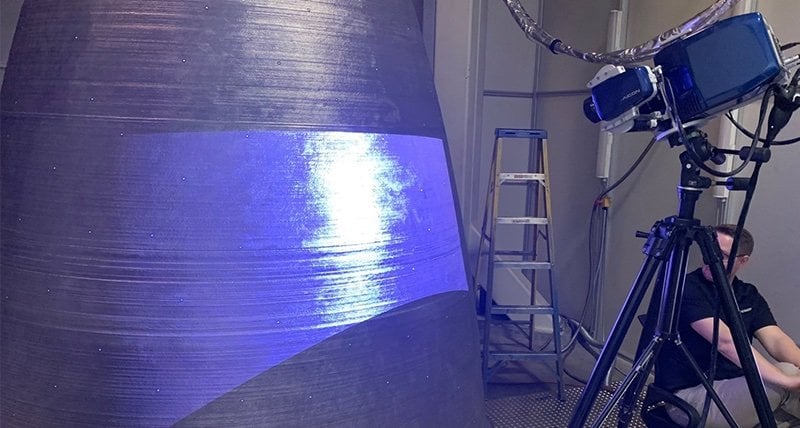www.ptreview.co.uk
22
'21
Written on Modified on
Hexagon enables big ambitions for Directed Energy Deposition DED additive manufacturing
Hexagon’s Manufacturing Intelligence division has revealed new developments that advance the application of Directed Energy Deposition (DED) technologies to industrial applications, including collaborations with printer manufacturers pro-beam, Sciaky, DM3D, Gefertec and Meltio.

DED incorporates several metal 3D printing technologies used to produce parts by melting and fusing material as it is deposited. Applicable to a broad range of part sizes, it is attractive for the cost-effective production of large parts – from one to six or more metres – that may be impossible to manufacture using powder bed fusion (PBF) technologies. Indeed, SmarTech Analysis estimates revenues form large-format metal additive technologies and related areas will reach US $739 million in 2026.
Sharing core technologies with mature coating and welding processes, DED is rapidly gaining traction for military and aerospace Maintenance, Repair and Operations (MRO) because it can repair or rebuild high-end equipment, such as turbine blades. It also offers innovation potential within hybrid manufacturing processes, where it can add material and features to workpieces finished with wire EDM or milling processes.
Driven by interest from the aerospace and defence industries, parts are often made from high-performance metal alloys such as titanium and high-temperature and stainless steels. Hexagon is working with printer OEMs, customers and service providers to help predict how these materials behave when subjected to the thermal-mechanical stresses of DED processes, which are compounded in large structures.
“We see significant demand for the use of our technologies in tandem to create customised, cost-effective solutions that meet the needs of specific additive manufacturing technologies in a variety of applications,” said Mathieu Pérennou, global business development director for additive manufacturing, Hexagon’s Manufacturing Intelligence division. “Optimising deposition production processes may entail taking advantage of powerful simulation tools, state-of-the-art scanning technology, robust reverse-engineering and analysis software, or a combination of all of these technologies to achieve the required quality and repeatability.”
pro-beam, a global expert in electron beam technology and machines has combined 45 years of experience in welding to build its new WEBAM (Wire Electron Beam Additive Manufacturing) 3D printers, including the electron beam guns, in-house. Its new PB WEBAM 100, unveiled at Formnext 2021, employs an innovative vacuum chamber design to produce high-quality parts from challenging materials such as pure copper and titanium. Using Hexagon technologies, it validated a 100% virtual design-for-manufacturing workflow for this new wire-based electron beam printer using a structural aerospace part.
Hexagon’s Simufact Welding was used to create a robust a DED simulation model that accounts for all pro-beam’s proprietary vacuum conditions, clamping locations, and power adjustments to predict stresses, strains, and distortions. The new printer successfully produced the part from 35 layers of titanium wire using an electron beam in the vacuum chamber. The printed part was scanned using Hexagon’s state-of-the-art AS1 Absolute scanner and REcreate reverse engineering software, then compared to the final part geometry predicted by the simulation using VGMETROLOGY geometry analysis software from Volume Graphics.
Verena Uhl, product manager, pro-beam commented: “Hexagon has the capability to both accurately predict and then accurately measure our WEBAM process, which gives us and customers confidence in our innovative new additive methods. The simulation has a very strong dimensional correlation and shows very similar bending of the base plate to the real part. Having reduced simulation time by a factor of 13 without any loss of result quality, it is clear we can rely on Hexagon’s technologies for robust virtual engineering.”
Sciaky, Inc., a leading provider of additive manufacturing solutions, has likewise formed a partnership with Hexagon to ensure that its customers can use the company’s electron-beam (EBAM®) 3D printers to their full potential. Pairing EBAM printers with Hexagon’s process simulation software for DED applications ensures that the sophisticated printing technology can be leveraged for optimal productivity.
DED service bureau and machine builder DM3D used Hexagon measurement technologies to prove that it could meet NASA’s tolerance requirements in producing a full-scale NASA RS-25 nozzle liner, 111 inches (app. 2.8 meters) in height and 96 inches (app. 2.4 meters) in diameter, as part of NASA’s Rapid Analysis and Manufacturing Propulsion Technology (RAMPT) project.
“Hexagon’s experience and portable metrology technology has proved very valuable for validating the RAMPT RS-25 liner part and generating an accurate model for finish machining,” commented Dr. Bhaskar Dutta, president, DM3D Technology: “It is one of the largest DED builds ever made, so we needed a good and reliable inspection technique for part validation. It’s obviously not practical to move a 2-ton rocket engine part to a CMM for inspection. By accurately and quickly measuring the part inside the machine, we also see the opportunity to perform any rework on the part, had it been needed.”
Meltio, a disruptive laser metal deposition technology manufacturer, has added Hexagon’s ESPRIT CAM computer-aided manufacturing (CAM) software to its technology ecosystem, offering machine shops a single interface for preparing and programming high-quality hybrid direct energy deposition (DED) production and machining.
The collaboration streamlines subtractive and additive manufacturing workflows for users of the Meltio Engine CNC Integration system. Meltio’s hybrid manufacturing solution allows for the creation of complex parts with precision machining tolerances in a single step. Combining this pioneering technology with Hexagon’s ESPRIT CAM system CNC programming, optimisation, and simulation for both additive and subtractive processes results in an advanced but easy-to-use manufacturing workflow in a single tool.
For more additive manufacturing resources and information, please visit https://iamready.hexagonmi.com
www.hexagonmi.com

